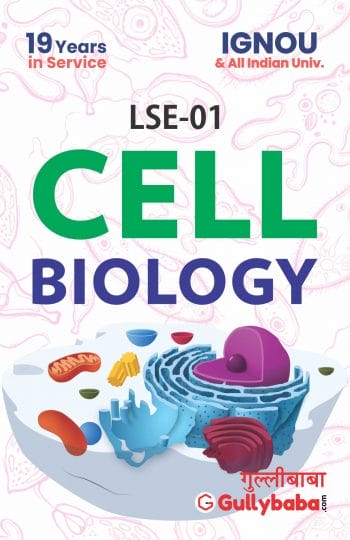#1 Best Selling IGNOU LSE-01 Help-Book & Study-Guide in IGNOU Marketplaces.
Get Good Marks in your B.Sc. Life Science Programme in the Term-End Exams even if you are busy in your job or profession.
We've sold over 64,250,647 Help Books and Delivered 81,077,152 Assignments Since 2002.
As our customers will tell you...yes, it really result-oriented.
IGNOU LSE-01 Code Details
-
University
IGNOU (Indira Gandhi National Open University)
-
Title
Cell Biology
-
Language(s)
English
-
Code
LSE-01
-
Subject
Life Science
-
Degree(s)
B.Sc.
-
Course
Core Courses (CC)
IGNOU LSE-01 English Topics Covered
Block 1 - Introduction of Cell Biology
- Unit 1 - Introduction to the Cell
- Unit 2 - How Cells are Studied?
- Unit 3 - Functional Ultra-Structure of the Cell
- Unit 4 - Molecules of the Cell
- Unit 5 - Macro-Molecules of the Cell
Block 2 - Cell Membranes and Enzymes
- Unit 1 - Supra-molecular Structures and Cell Membranes
- Unit 2 - Membrane Transport Processes
- Unit 3 - Transport Molecules and Proton Pumps
- Unit 4 - Enzymes: Specificity and Mechanism of Action
- Unit 5 - Enzymes: Regulation and Control
Block 3 - Metabolism and Communication in Cells
- Unit 1 - Energy Releasing Pathways
- Unit 2 - Biosynthesis
- Unit 3 - Nucleus: Structure and Function
- Unit 4 - Protein Biosynthesis
- Unit 5 - Chemical Signalling between Cells
Block 4 - Cell Division, Cell Movement and Differentiated Cell Types
- Unit 1 - Cell Cycle and Mitosis
- Unit 2 - Meiosis and Cell Division
- Unit 3 - Cell Adhesion, Cell Movement and Extracellular Matrix
- Unit 4 - Differentiated Animal Cell Types
- Unit 5 - Differentiated Plant Cell Types
IGNOU LSE-01 (January 2024 - December 2024) Assignment Questions
1. State one important function of each of the following:
i) F1 particles
ii) cytochrome b
iii) Plasmodesmata
iv) Myelin sheath
v) Thrombocytes
2. Differentiate between the following pairs:
i) Ion exchange and Affinity chromatography
ii) m-RNA and t-RNA
iii) Microtubules and Microfilaments
iv) Phagocytosis and Pinocytosis
3. Write short notes on any of the following:
i) Autoradiography
ii) Structure of plasma membrane
iii) Meiosis I
iv) cAMP as second messenger in cell
4. Draw neat and well labelled diagrams of the following:
i) A motor neuron
ii) Watson and Crick model of DNA
5. Name the major macromolecules present in the cell. Describe any two methods of separating macromolecules on the basis of differences in their molecular weight.
6. a) Describe the components of fluid connective tissue in animals.
b) What is meristem? Discuss its role in plants.
7. a) Explain enzyme kinetics
b) Discuss the genetic control of enzyme activity with the help of operon model.
8. a) Describe the structure and function of nuclear envelope
b) How is polypeptide chain synthesis initiated in prokaryotes?
9. Describe the formation of proton gradient caused by electron transfer in mitochondira, chloroplasts and bacteria.
10. Describe how glycolysis and TCA cycle are linked to each other.
IGNOU LSE-01 (January 2023 - December 2023) Assignment Questions
1. Write short notes on the following:
(i) Autoradiography
(ii) Gluconeogenesis
(iii) Cytokinesis
(iv) Phagocytosis
2. (a) Describe the structure of Golgi apparatus with the help of a well labelled diagram. List some of its important functions.
(b) Explain how protein synthesis in prokaryotes different from that in eukaryotes.
3. Differentiate between following pair of terms:
(i) Endocytosis and Exocytosis
(ii) Microtubules and microfilaments
(iii) DNA and RNA iv) Cilia and Flagella
4. (a) Describe the technique of column chromatography.
(b) Explain the structure of nerve cell with the help of a well labelled diagram.
5. Explain in detail the tricarboxylic acid (TCA) cycle with the help of a well labelled diagram.
6. (a) Describe various phases of cell cycle.
(b) Protein synthesis is regulated at various levels. Justify the statement giving a suitable explanation.
7. (a) Describe the molecular organization of cell membrane.
(b) Explain in brief the chemiosmotic theory.
8. (a) Describe the structure and function of tRNA.
(b) Describe double helix model of DNA.
9. Explain various stages of mitotic division with the help of suitable diagrams.
10. (a) What are allosteric enzymes? Describe their mechanism of action.
(b) Describe bacterial chemotaxis.
Buy LSE-01 Assignment
